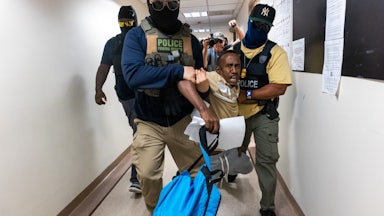The International Court of Justice’s July 19 ruling on Israeli settlements in the West Bank and East Jerusalem was stronger than anticipated, clearly articulating what is blatantly obvious, that these enclaves “and the regime associated with them, have been established and are being maintained in violation of international law,” said Nawaf Salam, president of the ICJ, as the court is also known. The Israeli government responded predictably, screaming “antisemitism” and declaring its sovereign and God-given right to exercise a hold over the occupied land. The State Department criticized the “breadth” of the ruling, saying that it would “complicate” efforts for resolving the situation between Israel and the Palestinians. Of course, presently, there are not only no efforts at resolution but there are also strategic Israeli efforts to expand the settlements enterprise. While the United States did and does maintain that “Israel’s program of government support for settlements is both inconsistent with international law and obstructs the cause of peace,” the settlements continue to blossom.
It’s amazing, actually, that it took decades for a ruling like this. (But it’s important also to note what the ICJ did not rule—they did not say that Israel itself is an apartheid state; they labeled the occupied territories as such.) After all, a 57-year occupation is not temporary. Any drive through the West Bank illustrates this to the naked eye, as I saw a week ago. There are the superhighways, the tunnels and bypasses, and increasingly newly legalized outposts and settlements engulfing the remaining land that belongs to Palestinian farmers and families.
Israel has occupied the West Bank and East Jerusalem since 1967. The 1993 Oslo Accords divided the land mass of the Occupied West Bank into three administrative areas labeled “A,” “B,” and “C.” The Palestinian Authority fully controls Area A (18 percent of the land), while it administers only civil matters in Area B (22 percent), and Israel maintains full control of Area C (60 percent). That is also the area that Israel will need to trade (along with the Gaza Strip) to the Palestinians for them to establish a viable independent state.
Oslo stipulated that neither side will create facts on the ground that undermine the final status, but the reality today belies that agreement. With no peace process ongoing, Israel continues to expand Jewish settlements, where today the growth is so sizable that it could make a two-state solution impossible. Moreover, the new population of settlers is especially messianic and militant. They will be dangerously difficult to move out.
There are an estimated three million Palestinians living in the West Bank, according to the State Department, and 500,000 Israeli settlers. There are an additional 230,000 Israeli Jews either living in East Jerusalem neighborhoods built after 1967, like Gilo and Ramot, or living among the 360,000 Palestinians. (East Jerusalem Palestinians do not have national status as Israelis, even though Israel claims a significant swath of East Jerusalem and Palestinian West Bank villages as part of “united Jerusalem, under Israeli rule.”)
Even before the ICJ ruling, a new international spotlight shone on the settlement growth and the increasing violence by Jewish settlers against Palestinian civilians, with the U.S., the United Kingdom, and the EU all adding sanctions against some of their key leaders and fundraising organizations. It’s likely that the ruling could bring about even more sanctions.
But the most important ringleaders remain unsanctioned—at least for the moment—including both settler leaders who serve in the Israeli government, Finance Minister Bezalel Smotrich and Homeland Security Minister Itamar Ben-Gvir. Their inclusion in the government—and Netanyahu’s overdependence on them to maintain his position as prime minister—gives them extraordinary power to permanently derail a two-state option. They actively promote permanent annexation. The saying on the Israeli anti-settlement left—that Israel is not a state that allows settlements but rather settlers who control a state—is truer than ever.
Smotrich, especially, continues to cement his control over the West Bank. Netanyahu has given him authority over roles once belonging to the army, thickening civilian hold on the Palestinian population and on land and building. His ally, Yehuda Alkalai, a settler leader, is the new chair of the Higher Planning Committee of the Israeli Civil Administration. Meanwhile, the Netanyahu government is pouring money into the settlements.
Just days before the ICJ ruling, I took a four-hour drive through almost the entirety of Area C to see the new settlement growth with Hagit Ofran, head of Peace Now’s Settlement Watch, an acknowledged expert on this topic, having covered it for more than two decades (I sit on the board of the related U.S. group Americans for Peace Now).
Ofran, whose grandfather was the great Orthodox Jewish scholar Yeshayahu Leibowitz (and one of the earliest opponents of the occupation after 1967), knows the signs to look for that show the deepening hold. The most immediate mark is the new infrastructure built by Israel, especially access roads for new settlements.
In a recent government meeting—which a Peace Now staffer recorded, unbeknownst to Smotrich—the finance minister bragged about the new money flow. “He explained that if you want to bring a million settlers, you have to have better roads,” Ofran told me. “That’s the key.”
Peace Now published a report on July 4 stating that the Israeli government approved the “advancement of 5,295 housing units in dozens of settlements throughout the West Bank. The building plans include the expansion of settlements deep within the West Bank and the legalization of three outposts, in addition to five outposts approved by the Israeli Cabinet in early July.”
Many of these settlements began with what are known as outposts, always illegal, though at this point the difference between “legal” and “illegal” housing by settlers is largely meaningless. An outpost begins simply. “You really just need a hilltop and a shack,” Ofran explained. “And two sheep.” The sheep are important because they graze on Palestinian farmland, disrupting and eventually stealing the fields.
But the settlers also use modern techniques. The skies over the hills, she explains, are filled with drones. “They use it to find Palestinian shepherds, Palestinian illegal construction, farmers and, in many cases, they use it to push out the Palestinian herds,” she said. “If you have a drone that goes over the sheep, they get crazy and run away.” And the Israeli government funds some of this. “They give them cars, they give them drones, cameras, electricity, and they fund roads sometimes,” Ofran said. “Every day we see a new road being paved somewhere.” When we drove through the territories, we saw new roads being paved, piles of stones dug up in preparation for other new roads, and paths of stones overturned, waiting for the cement trucks to arrive.
Even one family can hold down an outpost, doing massive damage to Palestinian farmland. Near Jericho, I saw a community of five caravans that had begun with just one woman and her infant daughter. Now there is a billboard featuring a large ultra-Orthodox family that reads, “We’re not on vacation; we live here; come join us.”
Elsewhere, near the settlement of Shiloh—which itself has grown through what settlers call “new neighborhoods,” which are actually entirely new settlements that jump from one hill to the other—I saw a girl in her teens or early twenties with a small herd of sheep next to a tent, in a strategic valley that split Palestinians’ farmland in two. These are the beginnings of outposts: tents, sheep and often-violent teens.
Sometimes, it’s not even that much. “They start with a truck,” Ofran says. “The truck is actually the house. You park it, and you live in it. You make it into a house. You can say, it’s not construction. I didn’t build anything. I just have a truck parked here.”
Settlers are policed by their own allies. Especially since October 7, many reservists in the Israeli Army are based on the West Bank—settlers protecting settlers. And knowing that little of consequence will happen to them under the Netanyahu government, settler violence against Palestinian civilians has grown. Ofran tells me: “They go down to the village, throw stones at houses, set fire, a lot of fires. Then, when Palestinians go out to shout at them or throw stones at them, they are attacked. Then the army comes and protects settlers. That’s the dynamics that we see.”
There are documents called land-sale registries, but they are not even remotely legal in the sense that anyone would consider them recording a normal legal land purchase. There are fake registries, settlers claiming they bought parcels from Palestinian farmers who were coerced by violence into selling, and simple abduction of land by the civil administration. There is never proof of purchase. And remember—the person in the Civil Administration who approves the new structures works directly for Smotrich.
“Well, it’s legal for Israel, but it’s not legal in terms of the world or anything else,” Ofran explains. “Yeah, there’s so many illegalities there. Yeah. I mean, what does it mean to be legal? The state says we’re legalizing it, but it’s not their land, it’s occupied land.… All settlements are illegal.”
Meanwhile, Israel is playing a shell game with itself. But it’s a game with real consequences, not only for the Palestinians under occupation but for the future of the state of Israel as a democracy and not a messianic theocracy.








